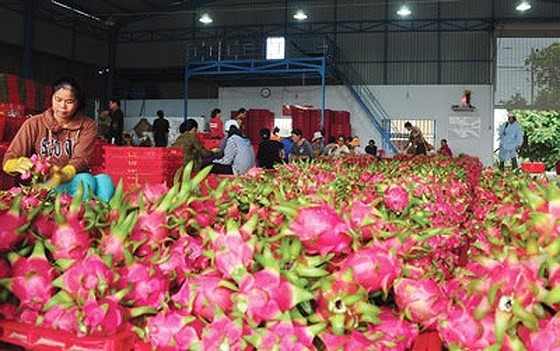
That data was synthesized from reports by plant quarantine divisions at Kim Thanh border gate in Lao Cai province, Thanh Thuy in Ha Giang, Tan Thanh in Lang Son and Mong Cai in Quang Ninh province.
The department has recently sent a delegation to survey dragon fruit export to China at norther border gates according to the ministry’s requirement, which has been made after information that dragon fruit price in southern and central regions dropped to VND1,000-2,000 a kilogram because Chinese traders have stopped buying.
According to Mr. Trung, China’s dragon fruit consumption demand is very high. Last year, Vietnam exported 1.5 million tons including 1.3 million tons to China.
Export volume reached 1.32 million tons in the first nine months this year. Of these, over one million tons were shipped through border gates in Lao Cai, Lang Son and Quang Ninh and 280,000 tons were exported by sea and air in HCMC.
Explaining the recent price drop in Binh Thuan, Tien Giang and Long An provinces, Mr. Le Son Tra, head of Plant Quarantine Division of the Plant Protection Department, said that there are many types of dragon fruits with different quality.
Those with low quality are paid only few thousands of dong a kilogram while eye catching and good quality type meeting export standards fetches VND20,000-25,000 a kilogram.
So the department rejected the information that China has stopped buying dragon fruit, saying the market has purchased up to 90 percent of Vietnamese dragon fruit.
Still the agency warned that Chinese Government has tightened import through border gates and improved standards on quarantine and food safety and origin tracking to Vietnamese fruits including dragon fruits.
Unofficial cross-border trade will be tightly controlled or even stopped so businesses should take the initiative in shifting to official export ways.
The Plant Protection Department admitted that China is now developing dragon fruit farming area in Guangxi and Hainan with the total area of 20,000 hectares. It is expected to reach 30,000 hectares early 2019. In addition, the country has hired land to for dragon fruit plantation in Laos and Cambodia. That will impact Vietnam’s dragon fruit export in the upcoming time.
The agency proposed the Ministry of Agriculture and Rural Development to assign Farm Produce Processing and Market Development Department to have detailed market research, collect more specific information about dragon fruit planting and consumption in China to assist Vietnamese farmers and businesses.
Moreover, the ministry should work with the Ministry of Foreign Affairs to boost negotiations with China to increase the number of border gates permitted to import Vietnamese fresh fruits including dragon fruits.
At a meeting in Hanoi on October 9, Minister of Agriculture and Rural Development Nguyen Xuan Cuong required authorized agencies to take the initiative in conducting market research and planning to prevent oversupply, bumper crop and price fall from recurring.
























